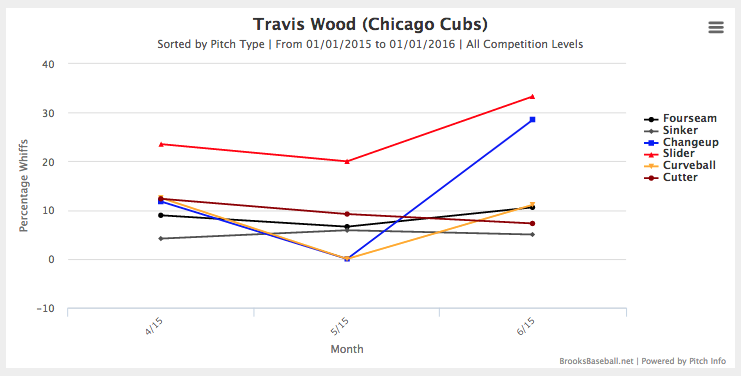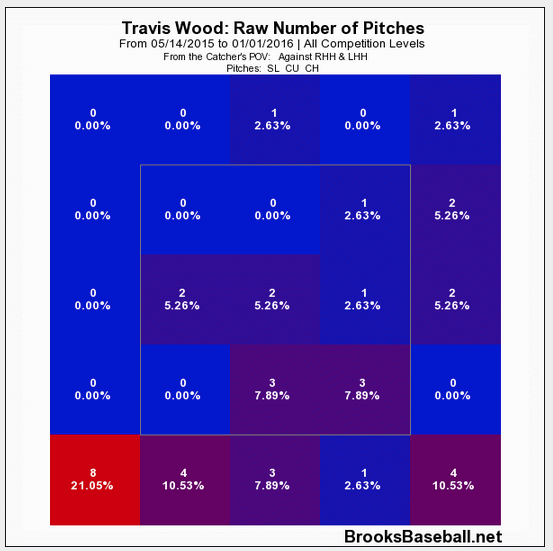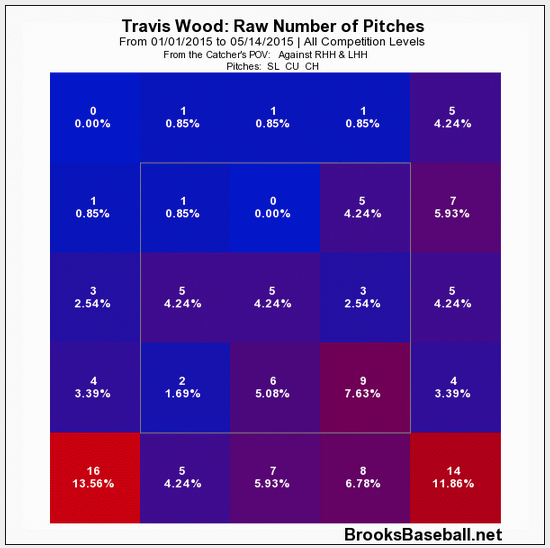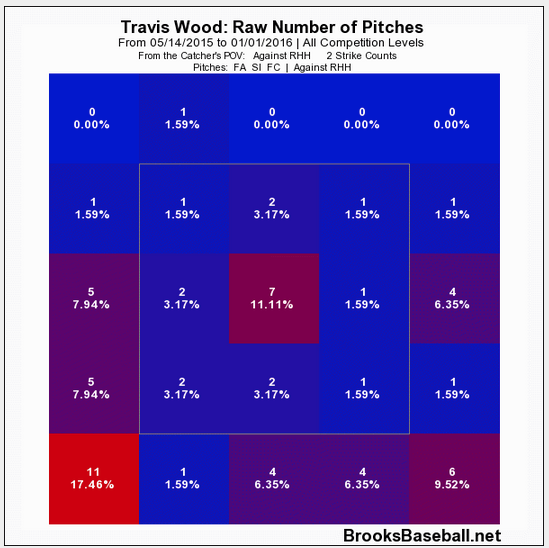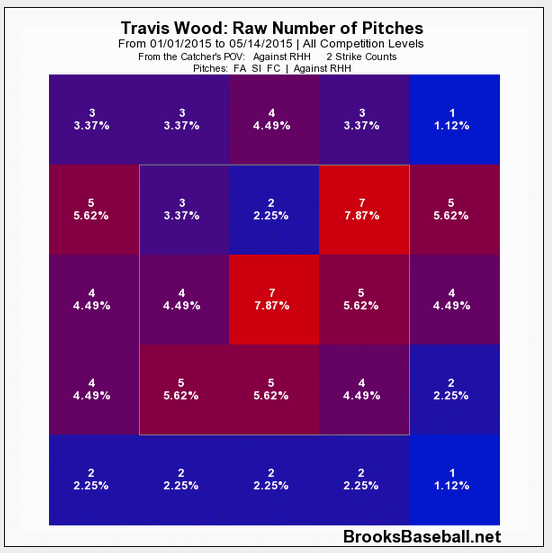Cubs fans have short memories. Travis Wood was actually really good in 2013, his second full season with the team. I mean, I know you, the educated reader, know he was really good, but perhaps the average reader wouldn’t know that his 4.2 DRA-derived WAR that season—which is a measure of a pitcher’s overall contribution to his team—was 11th in the entirety of major-league baseball. Better than Adam Wainwright, better than Felix Hernandez, and better than Justin Verlander. Yeah. Not just a little bit good. A lot bit good. He was an All-Star, and there was talk of a multi-year contract extension after the season concluded. Wood turned it down, confident in his abilities. But then 2014 happened. By the end of that year, his DRA had balooned from its 2013 value of 3.17 to an ugly 4.93, and Wood’s name became Mud in Chicago.
2015, at least to start with, wasn’t much better. After winning the fifth starter job in spring training—something he had not been asked to attempt in previous years—Wood allowed 23 earned runs over his first seven starts, resulting in a horrendous 5.59 ERA. On May 16th, two days after he managed just 4 1/3 innings against the Mets, manager Joe Maddon suddenly inserted him into the ninth inning of a close game against the Pirates, in the spot usually reserved for beleaguered closer Hector Rondon. Wood earned the save, and he’s been in the bullpen ever since.
Given that ignominious start to his season (and, honestly, his poor performance since the end of the 2013), I thought it would be worth drawing your attention to this, second, true fact about Travis Wood: he’s been a really good reliever this season. Over 16 1/3 innings pitched, he’s allowed just three runs, struck out 17, and walked just seven. That adds up to a 1.65 ERA which—wait for it—is good for 14th in the National League among relievers with as many innings. It’s also, not unimportantly, the second-best mark in the Cubs’ pen, after Justin Grimm (1.13). Wood’s performance is especially pleasing because his experience as a starter has allowed Maddon to rely on him for longer outings, where your typical lefty reliever wouldn’t be trusted. To wit, some basic numbers from his last four appearances:
| Date | IP | H | R | BB | K |
| 6/11 | 2.1 | 1 | 0 | 0 | 1 |
| 6/13 | 1.0 | 0 | 0 | 0 | 0 |
| 6/18 | 2.1 | 3 | 1 | 0 | 2 |
| 6/22 | 3.1 | 1 | 0 | 3 | 4 |
You’ll take that, and indeed the Cubs have. So where are we? Well, we know that Wood has been pretty good this year, as a reliever. And we know that he was pretty bad, as a starter. The interesting question, as always, is why. First, let’s take a look at his pitch mix for clues. Here’s a chart that shows Wood’s arsenal in 2015, first as a starter (by percentage of pitches thrown) and then as a reliever (by the same metric). Small sample size caveats apply, for the second sample, but there’s enough here that I think it’s worth digging into. The final row is just the percentage change, or delta, in the values:
| Role | Fourseam | Sinker | Cutter | Curve | Slider | Change |
| Starter | 34.60 | 25.24 | 21.43 | 5.40 | 5.87 | 7.46 |
| Reliever | 46.76 | 13.52 | 29.01 | 5.35 | 3.10 | 2.25 |
| Δ | +35.1 % | -46.4 % | +35.4 % | -0.9 % | -47.2 % | -69.8 % |
Holy four-seamer! Sweet baby cutter! Although the drops in slider and changeup usage are actually more dramatic, as a percentage, Wood never threw those pitches all that much to start with, and so their increased absence from his arsenal isn’t all that notable (nor is it surprising—relievers need fewer pitches than starters do). What really jumps off the page, however, is the increase in four-seam and cutter usage, and the corresponding drop in sinker usage. Whereas as a starter, Wood devoted approximately 81 percent of his arsenal to those three pitches, he now employs one of the three a whopping 89 percent of the time, with more than half of that coming from just one pitch, the four-seamer. So, what’s he doing with that four-seamer? Is he getting results?
Well, yeah, but not from the pitches you might expect. Here’s a graph showing Wood’s whiff percentage—the percentage of pitches swung and missed at—for the 2015 season, for all his pitches:
What I’m sure you’ve already noticed is that the three pitches which have seen the most improvement this season are those which I already, above, identified as the three pitches which Wood has started to use less as he’s transitioned into a bullpen role. Why would that be? Well, for one thing, they’re more surprising now. Wood, as a reliever, feeds hitters a steady diet of fastballs, getting them used to that speed, and then drops the hammer with a breaking or an offspeed pitch. That’s a formula for lots of strikes, and indeed Wood’s overall whiff rate has gone up as a reliever. But there’s something else: check out where Wood’s throwing his breaking and offspeed pitches now:
And here’s where he threw them before:
Huh, would you look at that. Wood’s still throwing breaking pitches away to lefties, but he’s basically stopped doing it entirely against righties. What’s he doing to them instead? Well, check out this graph for an answer:
With two strikes on right-handed hitters, Wood the reliever busts them inside and down with a fastball, when he can, or simply gears up and throws it past them. That’s his MO. That’s how he’s been getting people out. But wait! (you cry) What if that’s how he’s always gotten people out? Then this article won’t have taught us anything! Never you worry. Here’s what he did in the same situation as a starter:
What you see there is a lot of keeping the fastball away from right-handed hitters, and pretty much always up in the zone. No longer. Now he goes straight inside, and down, to bust their swings wide open. And it’s working for him. The idea that a starter would isolate particular elements of his repertoire upon a move to the bullpen is not particularly revelatory, by the way; if you have good enough stuff to be a big-league starter—and Wood was clearly that, if not a particularly good one—you definitely have good enough stuff to be a big-league reliever. You just have to find the appropriate way to harness what you’ve got to make it work for you. Wood has, and this article has therefore been, mostly, a few words about how. That how, in short, is by moving his arsenal back to the basics, and changing his approach against right-handed hitters somewhat. And that’s led to this truth: Travis Wood, in 2015, wasn’t a very good starter, but he’s been a very good reliever so far. And that’s very good for the Chicago Cubs, whose fans have such short memories. Indeed, since his move to the pen, Wood has been able to give those fans something new to remember.
Lead photo courtesy of Caylor Arnold-USA TODAY Sports

